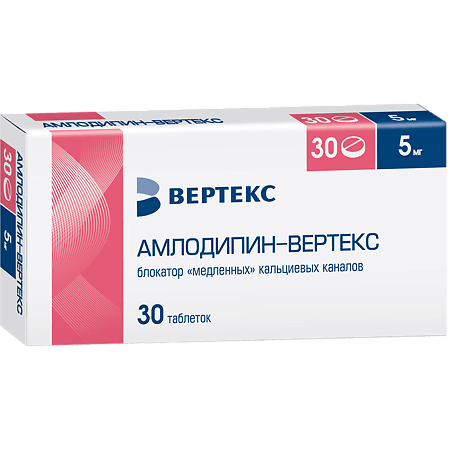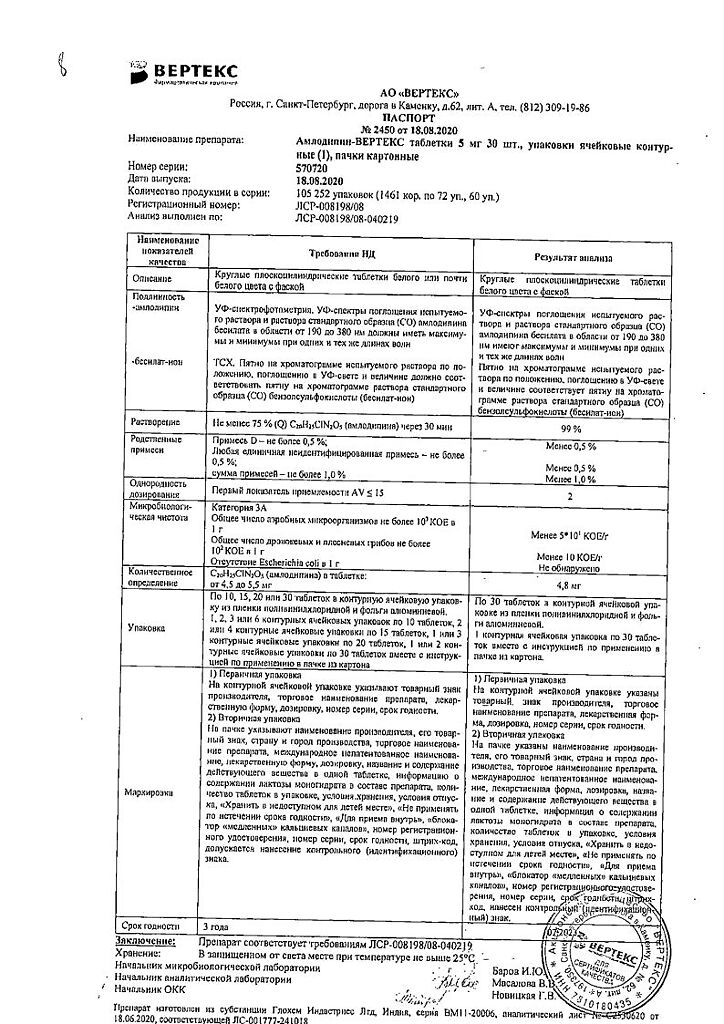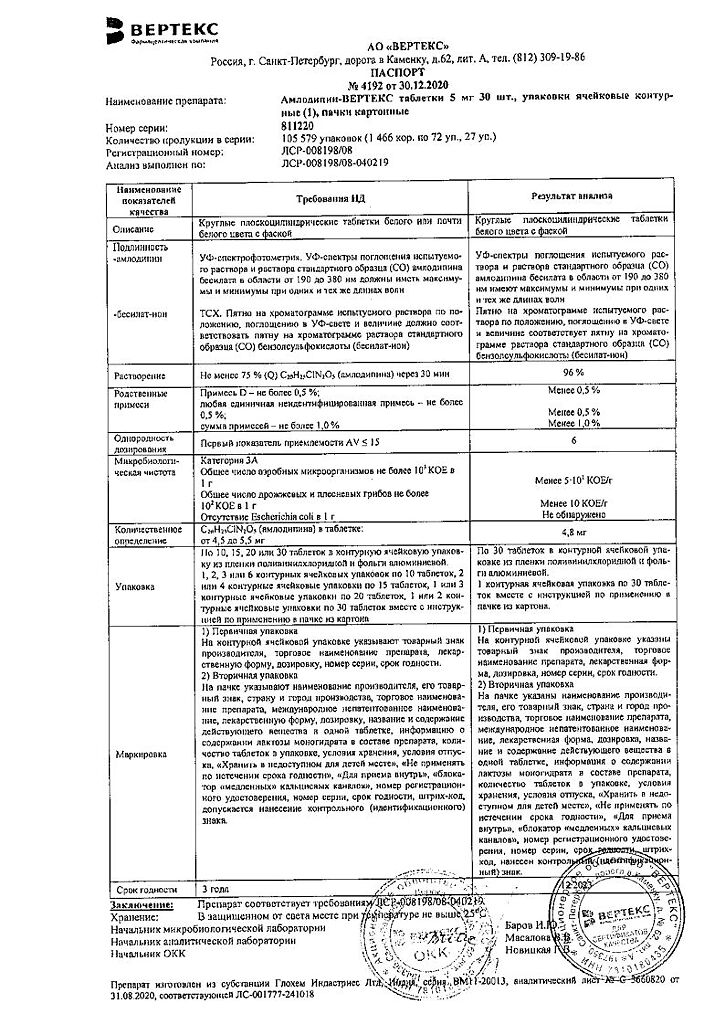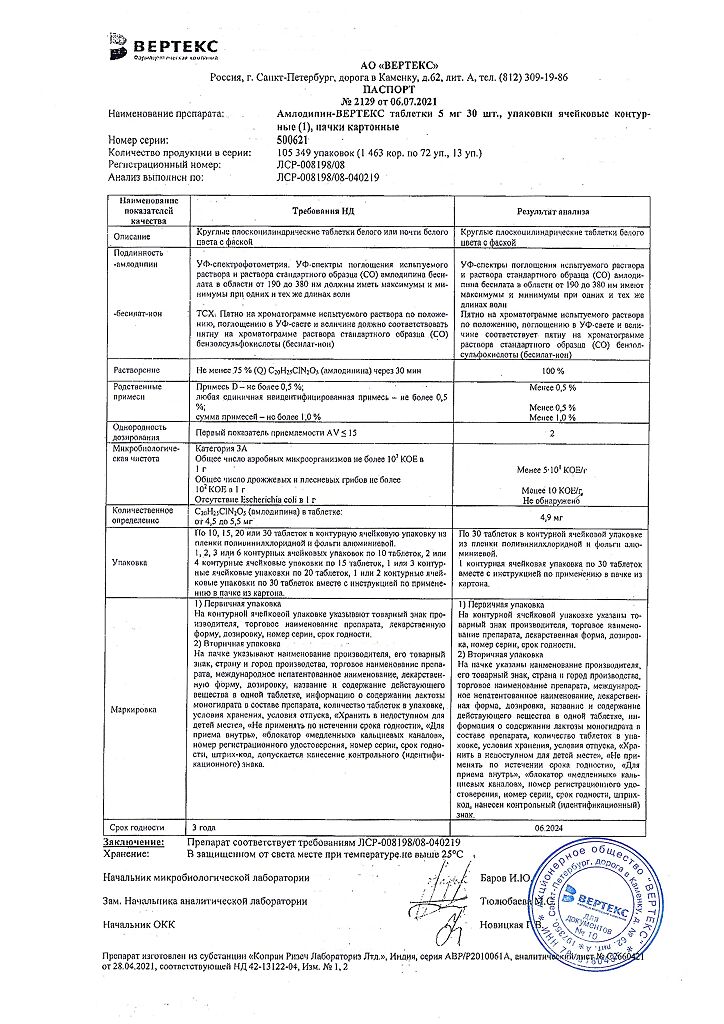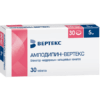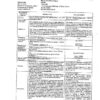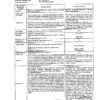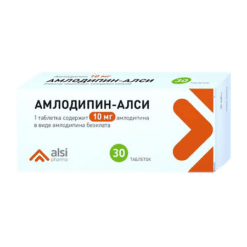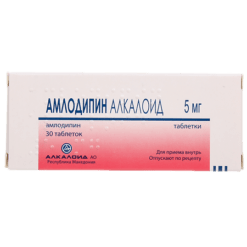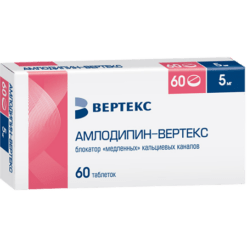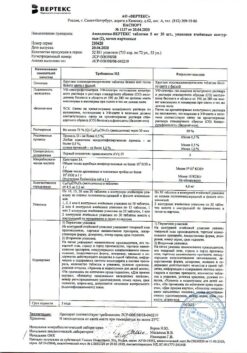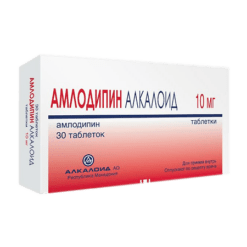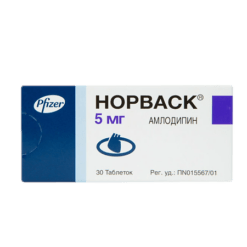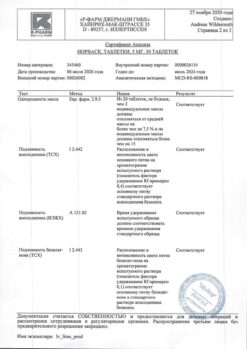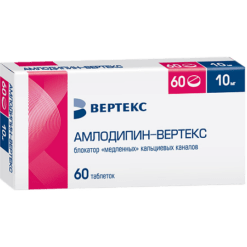No products in the cart.
Amlodipine-Vertex, tablets 5 mg 30 pcs
€2.44 €2.22
Out of stock
(E-mail when Stock is available)
Description
Amlodipine is a dihydropyridine derivative, a “slow” calcium channels blocker (BMCC) of II generation, has antianginal and hypotensive effects. By binding to dihydropyridine receptors, it blocks calcium channels, reduces transmembrane transfer of calcium ions into cells (more in vascular smooth muscle cells than in cardiomyocytes).
The antianginal action is caused by the dilation of coronary and peripheral arteries and arterioles: in angina pectoris it reduces myocardial ischemia; by dilation of peripheral arterioles it reduces total peripheral vascular resistance; reduces cardiac preload and myocardial oxygen demand.
Dilates main coronary arteries and arterioles in unchanged and ischemic areas of the myocardium, increases oxygen supply to the myocardium (especially in vasospastic angina); prevents development of coronary artery spasm (including that caused by smoking).
In patients with angina a single daily dose increases exercise tolerance, delays the development of another angina attack and “ischemic” ST-segment depression; reduces the frequency of angina attacks and nitroglycerin consumption. Amlodipine has a long-term dose-dependent hypotensive effect, which is due to a direct vasodilator effect on vascular smooth muscle. In arterial hypertension a single daily dose of amlodipine provides clinically significant reduction of arterial pressure (BP) for 24 hours (in “lying” and “standing” position of the patient).
Limits the degree of myocardial hypertrophy of the left ventricle, has anti-atherosclerotic and cardioprotective effect in CHD. It does not affect myocardial contractility and conduction, inhibits platelet aggregation, increases glomerular filtration rate, has a weak natriuretic effect.
In diabetic nephropathy it does not increase the severity of microalbuminuria. It has no adverse effect on metabolism and concentration of blood plasma lipids. Time of onset of therapeutic effect is 2-4 hours, duration – 24 hours.
Indications
Indications
Arterial hypertension (monotherapy or in combination with other antihypertensive drugs).
Stable exertional angina.
Prinzmetal’s angina (monotherapy or in combination with other antianginal drugs).
Pharmacological effect
Pharmacological effect
Amlodipine, a dihydropyridine derivative, is a second-generation slow calcium channel blocker (SCCC) that has antianginal and hypotensive effects. By binding to dihydropyridine receptors, it blocks calcium channels, reduces the transmembrane transition of calcium ions into the cell (more into vascular smooth muscle cells than into cardiomyocytes).
The antianginal effect is due to the expansion of coronary and peripheral arteries and arterioles: in case of angina pectoris, it reduces the severity of myocardial ischemia; by expanding peripheral arterioles, reduces total peripheral vascular resistance; reduces preload on the heart and myocardial oxygen demand.
Expands the main coronary arteries and arterioles in unchanged and ischemic areas of the myocardium, increases the supply of oxygen to the myocardium (especially with vasospastic angina); prevents the development of spasm of the coronary arteries (including those caused by smoking).
In patients with angina, a single daily dose increases tolerance to physical activity, delays the development of the next attack of angina and “ischemic” depression of the ST segment; reduces the frequency of angina attacks and nitroglycerin consumption. Amlodipine has a long-term dose-dependent hypotensive effect, which is due to a direct vasodilating effect on vascular smooth muscle. For arterial hypertension, a single daily dose of amlodipine provides a clinically significant decrease in blood pressure (BP) over 24 hours (in the patient’s “lying” and “standing” position).
Reduces the degree of left ventricular myocardial hypertrophy, has an antiatherosclerotic and cardioprotective effect in ischemic heart disease. It has no effect on myocardial contractility and conductivity, inhibits platelet aggregation, increases glomerular filtration rate, and has a weak natriuretic effect.
In diabetic nephropathy, it does not increase the severity of microalbuminaria. Does not have an adverse effect on metabolism and plasma lipid concentrations. The onset of the therapeutic effect is 2-4 hours, duration is 24 hours.
Special instructions
Special instructions
Use for liver dysfunction: in patients with liver dysfunction, Amlodipine is prescribed as an antihypertensive agent with caution, at an initial dose of 2.5 mg, and as an antiangial agent – 5 mg.
Use in renal failure: No dose adjustment is required in patients with renal failure.
In elderly patients: T1/2 may increase and creatinine clearance (CC) may decrease. No dose changes are required, but patients should be monitored more closely.
No dose change is required when administered concomitantly with thiazide diuretics, beta-blockers and angiotensin-converting enzyme (ACE) inhibitors.
During treatment with Amlodipine, it is necessary to monitor patients’ body weight and the amount of sodium salt they consume; an appropriate low-salt diet is prescribed. It is necessary to maintain dental hygiene and regularly visit the dentist (to prevent pain, bleeding and gum hyperplasia).
The dosage regimen of Amlodipine in elderly patients is similar to that in patients of other age groups. When increasing the dose, careful monitoring of elderly patients is necessary. Despite the absence of withdrawal syndrome in BMCC, a gradual dose reduction is recommended before stopping treatment.
Amlodipine does not affect plasma concentrations in the blood of potassium ions, glucose, triglycerides, total cholesterol, low-density lipoproteins, uric acid, creatinine and urea nitrogen. Abrupt discontinuation of the drug should be avoided due to the risk of worsening angina. Amlodipine tablets are not recommended for hypertensive crisis.
Patients with low body weight, patients of short stature and patients with severe liver dysfunction may require a lower dose.
Impact on the ability to drive vehicles and operate machinery
There have been no reports of the effect of Amlodipine on driving or operating machinery. However, some patients, mainly at the beginning of treatment, may experience drowsiness and dizziness. If they occur, care should be taken when driving vehicles and engaging in potentially hazardous activities that require increased concentration and speed of psychomotor reactions.
Active ingredient
Active ingredient
Amlodipine
Composition
Composition
1 tablet contains:
Active substance:
amlodipine besilate (in terms of amlodipine) – 5 mg.
Excipients:
calcium stearate,
potato starch,
lactose (milk sugar),
magnesium stearate,
microcrystalline cellulose.
Pregnancy
Pregnancy
Amlodipine was not found to be teratogenic in animal studies, but there is no clinical experience with its use during pregnancy and lactation.
Therefore, amlodipine should not be prescribed to pregnant women and during lactation, as well as to women of childbearing age if they do not use reliable methods of contraception.
Contraindications
Contraindications
Hypersensitivity to amlodipine, other dihydropyridine derivatives, and other components of the drug.
Severe arterial hypotension (systolic blood pressure less than 90 mm Hg).
Collapse.
Cardiogenic shock.
Unstable angina (with the exception of Prinzmetal’s angina).
Severe aortic stenosis.
Age up to 18 years (efficacy and safety have not been established).
Lactose intolerance, lactase deficiency or glucose-galactose malabsorption.
Pregnancy.
Lactation period.
Use the drug with caution in case of: liver dysfunction, sick sinus syndrome (severe bradycardia, tachycardia), chronic heart failure of non-ischemic etiology of functional class III-IV according to the NYHA classification, aortic stenosis, mitral stenosis, hypertrophic obstructive cardiomyopathy, acute myocardial infarction (and within 1 month after), old age.
Side Effects
Side Effects
From the cardiovascular system: often – palpitations, peripheral edema (swelling of the ankles and feet); uncommon – excessive decrease in blood pressure, orthostatic hypotension, vasculitis; rarely – development or worsening of chronic heart failure; very rarely – rhythm disturbances (bradycardia, ventricular tachycardia, atrial fibrillation), myocardial infarction, chest pain, migraine.
From the central nervous system: often – headache, dizziness, increased fatigue; uncommon – malaise, fainting, neuropsychic asthenia, hypoesthesia, paresthesia, peripheral neuropathy, tremor, insomnia, emotional lability, unusual dreams, nervousness, depression, anxiety; rarely – convulsions, apathy, agitation; very rarely – ataxia, amnesia.
From the hematopoietic organs: very rarely – thrombocytopenia, leukopenia, thrombocytopenic purpura.
From the respiratory system: infrequently – shortness of breath, rhinitis; very rarely – cough.
From the digestive tract: often – nausea, abdominal pain; uncommon – vomiting, change in bowel habits (including constipation, flatulence), dyspepsia, diarrhea, anorexia, dry oral mucosa, thirst; rarely – gum hyperplasia, increased appetite; very rarely – gastritis, pancreatitis, hyperbilirubinemia, jaundice (usually cholestatic), increased activity of “liver” transaminases, hepatitis.
From the genitourinary system: infrequently – pollakiuria, painful urge to urinate, nocturia, impotence; very rarely – dysuria, polyuria.
From the skin: rarely – increased sweating; very rarely – cold sticky sweat, xeroderma, alopecia, dermatitis, purpura, skin discoloration.
Allergic reactions: infrequently – skin itching, rash; very rarely – angioedema, erythema multiforme, urticaria.
From the musculoskeletal system: infrequently – arthralgia, muscle cramps, arthrosis, myalgia (with long-term use), back pain; rarely – myasthenia.
Other: infrequently – alopecia, tinnitus, gynecomastia, weight gain/loss, blurred vision, diplopia, accommodation disturbance, xerophthalmia, conjunctivitis, eye pain, taste perversion, chills, nosebleeds, increased sweating; rarely – dermatitis; very rarely – cold sticky sweat, parosmia, skin pigmentation disorder, hyperglycemia.
Interaction
Interaction
Inhibitors of microsomal oxidation may increase the concentration of amlodipine in the blood plasma, increasing the risk of side effects, and inducers of microsomal liver enzymes may reduce this indicator.
Unlike other BMCCs, amlodipine does not have a clinically significant interaction with non-steroidal anti-inflammatory drugs, especially indomethacin.
Thiazide and loop diuretics, beta-blockers, verapamil, ACE inhibitors and nitrates enhance the antianginal or hypotensive effects of amlodipine.
Amiodarone, quinidine, alpha 1-blockers, antipsychotics (neuroleptics) and isoflurane may enhance the hypotensive effect of amlodipine.
Calcium supplements may reduce the effect of BMCC.
When amlodipine is used together with lithium drugs, it is possible to increase the manifestations of neurotoxicity of the latter (nausea, vomiting, diarrhea, ataxia, tremor, tinnitus).
Amlodipine has no effect on the pharmacokinetic parameters of digoxin and warfarin.
Cimetidine does not affect the pharmacokinetics of amlodipine.
Antiviral drugs (ritonavir) help increase the concentrations of BMCC (including amlodipine) in the blood plasma.
Overdose
Overdose
Symptoms:
a pronounced decrease in blood pressure with the possible development of reflex tachycardia and excessive peripheral vasodilation (risk of developing severe and persistent arterial hypotension, including the development of shock and death).
Treatment:
gastric lavage, administration of activated charcoal (especially in the first 2 hours after an overdose), maintaining the function of the cardiovascular system, monitoring indicators of heart and lung function, Trendelenburg position, monitoring circulating blood volume and diuresis. To restore vascular tone, use vasoconstrictor drugs (in the absence of contraindications to their use); to eliminate the effects of blockade of calcium channels – intravenous administration of calcium gluconate. Hemodialysis is not effective.
Storage conditions
Storage conditions
Store in a dry place, protected from light, at a temperature not exceeding 25°C.
Shelf life
Shelf life
3 years.
Manufacturer
Manufacturer
Vertex, Russia
Additional information
| Shelf life | 3 years. |
|---|---|
| Conditions of storage | Store in a dry, light-protected place at a temperature not exceeding 25 ° C. |
| Manufacturer | Vertex, Russia |
| Medication form | pills |
| Brand | Vertex |
Other forms…
Related products
Buy Amlodipine-Vertex, tablets 5 mg 30 pcs with delivery to USA, UK, Europe and over 120 other countries.

